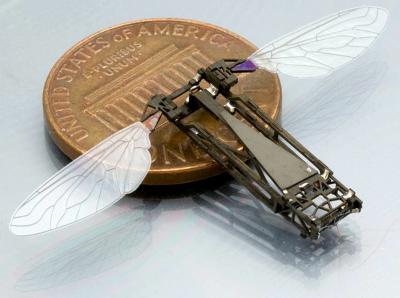In a research funded by U.S defence agencies, a research team from John Hopkins University are studying the manner in which butterflies flutter to develop small flying robots having the ability to do similar maneuvers.
 The butterfly research will aid the development of flying bug-size robots. Pictured is an insect-inspired flapping-wing micro air vehicle under development at Harvard University. Credit: Robert J. Wood, associate professor, and Pratheev Sreetharan, Microrobotics Lab, Harvard University
The butterfly research will aid the development of flying bug-size robots. Pictured is an insect-inspired flapping-wing micro air vehicle under development at Harvard University. Credit: Robert J. Wood, associate professor, and Pratheev Sreetharan, Microrobotics Lab, Harvard University
The research is being carried out to develop such robots for search and rescue and reconnaissance and other missions to monitor the environment without affecting human beings. Such small vehicles are also called micro aerial vehicles or MAVs.
The main drawback for such vehicles is their lack of maneuverability since they are required to fly through turbulent winds and limited spaces. The research is being supervised by professor of mechanical engineering, Rajat Mittal. For the purpose of this study, the team has used high speed video to observe the changes in mass distribution when the wings of the insect flap and the way in which the insect’s body deforms in order to achieve fast turns and twists. Three cameras were arranged in a way in which three dimensional images could be recorded. After studying the images it was established that changes during the moment of inertia play a significant role in the flight of insects. This discovery is expected to be very useful to scientists who study the flight of insects and MAV designers.